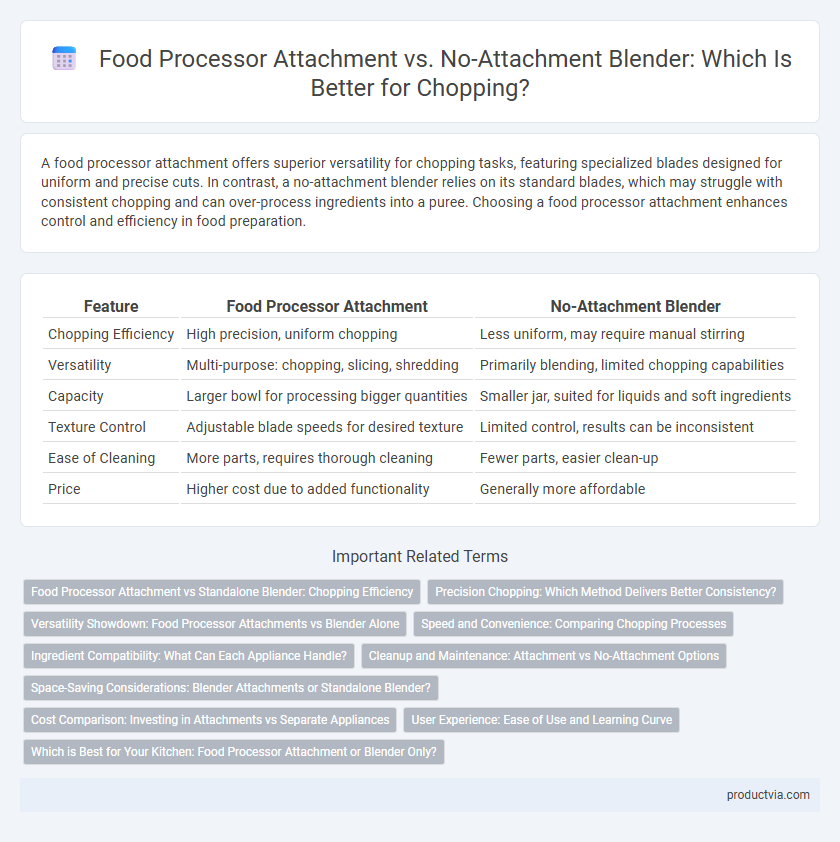A food processor attachment offers superior versatility for chopping tasks, featuring specialized blades designed for uniform and precise cuts. In contrast, a no-attachment blender relies on its standard blades, which may struggle with consistent chopping and can over-process ingredients into a puree. Choosing a food processor attachment enhances control and efficiency in food preparation.
Table of Comparison
| Feature | Food Processor Attachment | No-Attachment Blender |
|---|---|---|
| Chopping Efficiency | High precision, uniform chopping | Less uniform, may require manual stirring |
| Versatility | Multi-purpose: chopping, slicing, shredding | Primarily blending, limited chopping capabilities |
| Capacity | Larger bowl for processing bigger quantities | Smaller jar, suited for liquids and soft ingredients |
| Texture Control | Adjustable blade speeds for desired texture | Limited control, results can be inconsistent |
| Ease of Cleaning | More parts, requires thorough cleaning | Fewer parts, easier clean-up |
| Price | Higher cost due to added functionality | Generally more affordable |
Food Processor Attachment vs Standalone Blender: Chopping Efficiency
Food processor attachments excel in chopping efficiency due to their specialized blades and wider bowls, allowing for uniform and precise cuts of vegetables, nuts, and herbs. Standalone blenders typically struggle with consistent chopping, as their fixed blade design and narrower containers create uneven textures and require shorter pulse bursts. Choosing a food processor attachment over a standalone blender significantly enhances control and speed when preparing finely chopped ingredients.
Precision Chopping: Which Method Delivers Better Consistency?
Food processor attachments in Blender offer enhanced precision chopping due to their dedicated blades and consistent motor speed, ensuring uniform food particle sizes ideal for recipes requiring exact texture. No-attachment blenders, while versatile, often produce uneven chops because of less specialized blades and variable blade contact with ingredients. Therefore, for tasks demanding high consistency, food processor attachments outperform standard blender configurations in precision chopping performance.
Versatility Showdown: Food Processor Attachments vs Blender Alone
Food processor attachments offer superior versatility for chopping a wide range of ingredients, including tougher items like nuts and dense vegetables, due to their powerful motor and specialized blades. In contrast, a blender without attachments excels mainly in liquid-based tasks and softer foods but struggles with consistent chopping, often resulting in uneven textures. Choosing between the two depends on whether you prioritize multi-functionality and precise chopping or simpler, liquid blending capabilities.
Speed and Convenience: Comparing Chopping Processes
A food processor attachment in Blender significantly enhances chopping speed by providing dedicated blades and higher torque designed for efficiently processing various food textures. In contrast, a no-attachment blender relies on general-purpose blades that may require longer blending times and frequent pulse adjustments to achieve desired chop consistency. The convenience of quick switching between blending and chopping functions in Blender's food processor attachment streamlines meal preparation and reduces cleanup compared to standalone no-attachment blenders.
Ingredient Compatibility: What Can Each Appliance Handle?
Food processor attachments in Blender excel at handling tough, dense ingredients like nuts, hard vegetables, and dough due to their powerful blades and specialized design. No-attachment blenders are better suited for softer ingredients, such as fruits, cooked vegetables, and liquids, providing smooth textures but often struggling with thick or fibrous materials. Ingredient compatibility hinges on the appliance's blade configuration and power, making food processor attachments ideal for heavy-duty chopping and no-attachment blenders optimal for lighter, softer food preparation tasks.
Cleanup and Maintenance: Attachment vs No-Attachment Options
Food processor attachments in Blender systems often feature detachable components that simplify cleanup by allowing users to separate blades and containers for thorough washing. No-attachment blenders typically have integrated blades and fewer parts, which reduces the effort required for disassembly but can make cleaning around the blades more challenging. Choosing between these options depends on balancing the convenience of quick cleanup in no-attachment designs against the deeper sanitation achievable with removable food processor attachments.
Space-Saving Considerations: Blender Attachments or Standalone Blender?
Blender attachments for food processing maximize kitchen efficiency by combining multiple functions in one device, reducing countertop clutter. Standalone blenders, while often more powerful for chopping, require separate storage space, potentially increasing kitchen congestion. Choosing attachments minimizes the need for extra appliances, making them ideal for small kitchens with limited storage.
Cost Comparison: Investing in Attachments vs Separate Appliances
Food processor attachments for blenders provide a cost-effective alternative to purchasing a separate appliance, often priced significantly lower than standalone food processors. These attachments leverage the existing blender motor, reducing the need for additional devices and saving kitchen space. While standalone food processors may offer specialized features, investing in attachments maximizes value by combining functions within one machine.
User Experience: Ease of Use and Learning Curve
The food processor attachment in Blender offers enhanced ease of use for chopping tasks due to its specialized blade design and larger capacity, reducing the need for multiple sessions. In contrast, a no-attachment blender requires careful pulse control and shorter blend intervals, which may increase the learning curve for consistent chopping results. Users typically find the food processor attachment more intuitive and efficient, especially for varied chopping textures and larger quantities.
Which is Best for Your Kitchen: Food Processor Attachment or Blender Only?
Food processor attachments offer specialized blades and higher torque for precise chopping of vegetables, nuts, and dough, outperforming standard blender-only models designed for blending and pureeing. A no-attachment blender provides versatility for smoothies and liquids but may struggle with uniform chopping and tougher ingredients. Choosing between them depends on your kitchen needs: food processor attachments excel in prep efficiency, while blender-only units favor multi-function convenience.
Food processor attachment vs No-attachment blender for chopping Infographic

 productvia.com
productvia.com